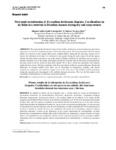Por favor, use este identificador para citar o enlazar este ítem:
http://www.alice.cnptia.embrapa.br/alice/handle/doc/1030696Registro completo de metadatos
| Campo DC | Valor | Lengua/Idioma |
|---|---|---|
| dc.contributor.author | GENTIL-VASCONCELOS, H. C. | pt_BR |
| dc.contributor.author | TAVARES-DIAS, M. | pt_BR |
| dc.date.accessioned | 2015-12-04T11:11:11Z | pt_BR |
| dc.date.available | 2015-12-04T11:11:11Z | pt_BR |
| dc.date.created | 2015-12-04 | pt_BR |
| dc.date.issued | 2015 | pt_BR |
| dc.identifier.citation | Latin American Journal of Aquatic Research, v. 43, n. 5, p. 936-943, 2015. | pt_BR |
| dc.identifier.uri | http://www.alice.cnptia.embrapa.br/alice/handle/doc/1030696 | pt_BR |
| dc.description | We analyzed the infestation levels of Excorallana berbicensis on Acestrorhynchus falcirostris, Ageneiosus ucayalensis, Geophagus proximus, Hemiodus unimaculatus, Psectrogaster falcata and Serrasalmus gibbus in a reservoir in the Araguari River basin, northern Brazil, during the dry and rainy seasons. For P. falcata, the infestation levels due to E. berbicensis were greater during the rainy season. For all the species studied, the peak parasite prevalence was in the month of highest rainfall levels and there were two peaks of parasite abundance: one in the month with highest rainfall level and the other in the month of transition from the rainy season to the dry season. In these hosts, around 70% of the E. berbicensis specimens were collected during the rainy season. The body conditions of the hosts also did not suffer any seasonal influence. Despite the differences in seasonal rainfall levels, there was no fluctuation in transparency, turbidity, pH, electric conductivity, temperature and dissolved oxygen levels in the water, due to the stability of these parameters during the seasonal cycle investigated in this artificial Amazon ecosystem. This was the first report on the seasonality of infestation by E. berbicensis associated with fish. | pt_BR |
| dc.language.iso | eng | eng |
| dc.rights | openAccess | eng |
| dc.subject | Parasite animal | pt_BR |
| dc.subject | Parasito animal | pt_BR |
| dc.title | First study on infestation of Excorallana berbicensis (Isopoda: Corallanidae) on six fishes in a reservoir in Brazilian Amazon during dry and rainy seasons. | pt_BR |
| dc.type | Artigo de periódico | pt_BR |
| dc.date.updated | 2017-03-14T11:11:11Z | pt_BR |
| dc.subject.thesagro | Climatologia | pt_BR |
| dc.subject.thesagro | Variação sazonal | pt_BR |
| dc.subject.nalthesaurus | climatology | pt_BR |
| dc.subject.nalthesaurus | seasonal variation | pt_BR |
| riaa.ainfo.id | 1030696 | pt_BR |
| riaa.ainfo.lastupdate | 2017-03-14 | pt_BR |
| dc.contributor.institution | HUANN CARLLO GENTIL-VASCONCELOS, Postgraduate Program on Tropical Biodiversity (PPGBIO) - Federal University of Amapá Macapá, AP, Brazil; MARCOS TAVARES-DIAS, CPAF-AP. | pt_BR |
| Aparece en las colecciones: | Artigo em periódico indexado (CPAF-AP)  | |
Ficheros en este ítem:
| Fichero | Descripción | Tamaño | Formato | |
|---|---|---|---|---|
| CPAFAP2015Firststudyoninfestation.pdf | 772.19 kB | Adobe PDF |  Visualizar/Abrir |









